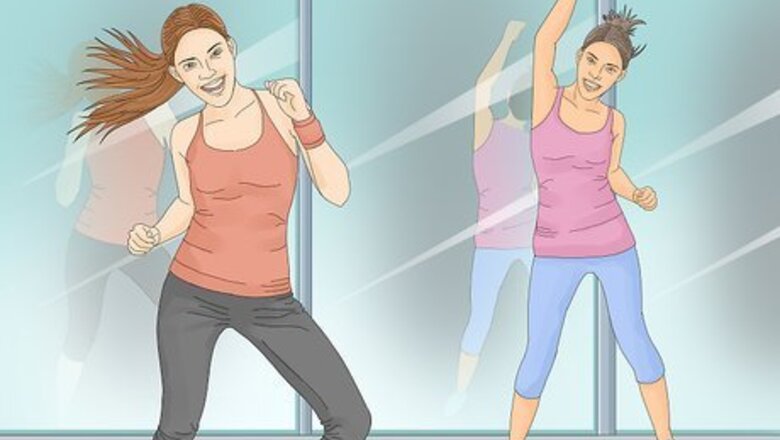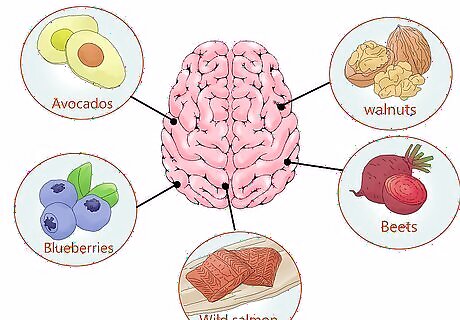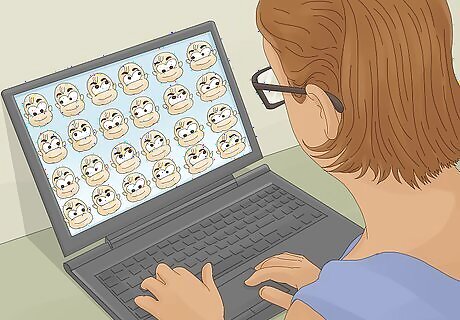
views
We interviewed brain health physician Michael Lewis to find out the best ways you can improve your brain health and cognitive function.
Developing a Brain-Healthy Lifestyle

Get plenty of aerobic exercise. We think of the brain’s processing speed similarly to how electrical signals travel across wiring connections. In the brain, these wiring connections are called axons. The brain's white matter is made up of all of this wiring and is fed by blood vessels, meaning that vascular problems such as diabetes and high blood pressure can starve the axons of much-needed oxygen and glucose. Therefore, staying fit and getting plenty of aerobic exercise is the number one suggestion by most neurologists to sustain axons and even potentially improve processing speeds. A regular cardio routine has also been linked to an increase in the birth of new neurons in the hippocampus, which is a part of the brain important to learning and processing. As brain health physician Michael Lewis says, “You need exercise. You need blood flow to the brain. Aerobic exercise—getting your heart rate up gets blood flow to the brain—which helps the brain recover.”

Eat the right foods. Physical health goes hand in hand with brain health. Maintaining a balanced diet is just as important as getting the right amount of exercise. Try adding more of these foods to your diet to improve overall brain health: Avocados: Avocados are great at assisting in the prevention of vascular conditions, such as high blood pressure, and healthy blood flow is essential for a healthy brain. Avocados are high in fat, so limit yourself to a quarter or half an avocado a day. Blueberries: Blueberries are packed with antioxidants, which means they protect the brain from oxidative stress and may reduce the effects of age-related conditions. Aim for 1 cup (16 US tbsp) of blueberries per day. Wild salmon: Omega-3 essential fatty acids, such as DHA, are essential for brain function. Deep-water fish such as salmon, sardines, and herring are full of them. Aim to eat a 4 ounces (110 g) serving 2 to 3 times per week. Nuts and seeds: Nuts and seeds are a great source of vitamin E, which helps fight cognitive decline as we age. Try to add 1 ounce (28 g) a day. Beets: Beets can increase blood flow to the brain, which may help improve your cognition. Try eating beets in a salad or drink beet juice.

Get the proper amount of sleep each night. The National Institutes of Health recommends that adults get approximately 7 to 8 hours of sleep every night and that teenagers get 9 hours. The brain forms new pathways while you sleep, and studies have shown that getting the right amount of sleep helps with learning, problem-solving skills, and memory. Sleep also plays a role in the body’s repair of the heart and blood vessels, which fuel the white matter of the brain. Sleep deficiency—even losing just 1 to 2 hours across several nights—can affect reaction time and processing time, making it longer to finish tasks. Long-term sleep deficiency has also been linked to vascular problems such as diabetes, heart disease, and high blood pressure, all of which can lead to depriving axons in the brain of oxygen and glucose.

Try nootropics. Nootropics are over-the-counter supplements that aim to improve brain function. These “smart drugs” may increase focus, attention, memory, and motivation. Some popular nootropics include: Bacopa Monnieri (Brahmi plant extract) L-theanine Racetams Artichoke extract Ginseng

Keep learning new things. Well into adulthood, the brain continues making new connections. Learning a task builds new connections, and mastering those connections strengthens the connections in a way that makes the information travel across axons more quickly. More specifically, when you learn, types of brain cells called glial cells can form sheaths of protein and fatty substances (called myelin sheaths) around axons that insulate the axons and subsequently speed electrical signals down them. Learning new skills can both increase myelin sheaths as well as form sheaths around formerly bare axons. Thicker myelin sheaths can improve a number of brainy tasks from reading to creating memories to decision-making.

Start playing an instrument. Some studies have shown that taking up an instrument can develop strong connections across different areas of the brain. The belief is that because musical training involves so many specific coordinations—visual to read music, auditory to listen to what you’re playing, and motor to finger the instrument—the connections between these brain areas become stronger and more tightly connected.

Maintain social networks. Not necessarily the online variety, but maintaining an active social life is good for your cognitive abilities. Lively discussion necessitates quick thinking, and maintaining strong social networks is a great way to challenge yourself mentally and keep you on your toes. Lewis also recommends socializing to improve overall brain health, as “people who are more social live longer and live happier.”

Stop smoking. If you don’t smoke, then don’t start. If you currently smoke, then strongly think about quitting. Beyond what smoking means for your risks of cancer and emphysema, it has also been shown to decrease overall brain volume, especially in the hippocampus. Smokers lose brain volume faster than nonsmokers, which can affect cognitive ability.
Trying Brain Games

Enlarge this picture by opening it in a new window. Brain games have been shown to sometimes have an effect on cognitive ability. Try your hand at this brain game by opening a large, clear version of the above image. The rise in popularity of brain games is too new for any long-term studies to prove specific improvements of brain function; however, many people feel that brain games have helped with their cognition. As Lewis reiterates, no game or activity is better than another. At the end of the day, “any is better than none.”

Call out the direction the eyes are looking in the picture. Starting at the top, move from left to right and top to bottom while calling out the direction the eyes are looking (down, left, up, right). Time yourself as you go through the faces, and try to do it without errors, first within 30 seconds, then within 15.

Start over from the face’s perspective. Once you’ve gotten quick at calling the directions, try calling the directions from the face’s perspective instead—as if you were the face looking out from the page. This approach is more difficult because it requires one additional processing step to correct for the face’s perspective. As with the first trial, time yourself and try to complete the picture without error at different milestones—30 seconds, then 15 seconds.

Go back to the first exercise but include opposite finger-pointing. Return to the exercise from step 2, but this time, point your finger in the opposite direction of the one you’re saying aloud for each face: “down [point up], left [point right], up [point down]…” This one will be even more difficult because you’ve added a motor skill component to the verbal component. Similar to the idea behind why musical training can improve processing speed, this exercise requires the coordination of multiple brain modalities—visual to interpret the information in the picture, verbal to say the direction aloud, and motor to point in coordination with the rest. You can also continue adding more components to the exercises. For instance, calling out the face’s perspective direction only when you reach green faces or on every third face.

Expand your repertoire of brain games. This is just one example of a brain game. Many websites are dedicated to timed games for reasoning, memory, and processing speed. You can also find various word games and logic puzzles online that aim to exercise one’s cognitive abilities. Luminosity, Brainist, Fit Brains, and Games for the Brain are all examples of websites dedicated to brain training. Outside of websites, you can also find brain-training app games for your mobile devices and games such as Brain Age for the Nintendo DS.




















Comments
0 comment